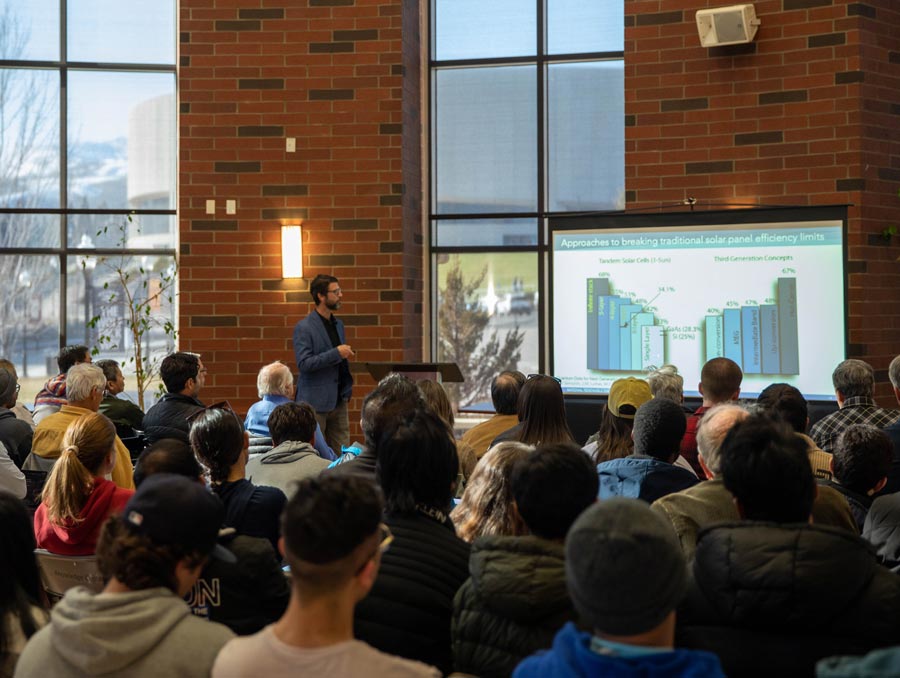Last week, solar panel scientist Joey Luther from the National Renewable Energy Laboratory (NREL) was on campus as part of the Energy Solutions Forum, hosted by the Colleges of Science and Engineering.
At NREL, Luther’s research is focused on improving the efficiency of solar panels using chemistry and engineering.
“At the beginning of my career, solar was a very small sector of the energy production, and throughout my career it has grown tremendously,” Luther said. “It’s been really exciting to be part of the path of solar becoming cheaper than traditional fossil fuel electricity.”
Luther studies both perovskite semiconductors and quantum dot solar cells. Perovskites are salts that form into a novel class of hybrid semiconductors, while quantum dots are nanoscale semiconductors, as small as one thousand atoms. Luther has also even combined these two types of solar cells, making perovskite quantum dot solar cells.
Today’s commercial solar panels generate heat at the cost of energy efficiency. Both perovskite semiconductors and quantum dot solar cells have unique properties that are able to retain much more energy in the form of electricity rather than heat.
Perovskites are crystalline structures which have been known for hundreds of years and can be found in thousands of different compositions. Halide perovskites were discovered to be applicable in solar panel technologies just ten years ago, and since then they have become hugely popular. Luther specifically studies lead halide organic-inorganic perovskites. This semiconductor system can withstand defects, meaning they will still work well if a few of the atoms aren’t quite in the right spot. That makes manufacturing efficient solar panels a lot more feasible and potentially able to produce solar panels at a much faster rate, leading to cost savings.
Additionally, perovskites are easy to deploy. Researchers were able to put the crystalline semiconductors into a liquid, spread the liquid on a surface and let it dry, like ink on paper. That layer of perovskite “ink” becomes a useful semiconductor.
After coming up with this simple design, researchers thought about bringing together silicon and perovskite panels. By combining technologies, perovskite/silicon tandem solar cells have been made with up to 32.9% efficiency.
“It basically allows you to make a panel that generates 50% more electricity than a silicon panel alone just by adding a few extra layers and an ink coating across the top of the device,” Luther said.
Despite advancements in the last few years, these new solar technologies still face a few challenges. The first is the environmental implications of various solvents used and the use of lead in solar panels. Luther acknowledges that lead isn’t ideal but points out that the proper analysis to consider is more complex. That analysis should consider the reduction in carbon emissions over a long period of operation in addition to the makeup of the products and ability to recycle them.
Another challenge is long-term operational stability of the solar panels. The solar panels that scientists at NREL are working on are very low-cost and very efficient. However, many silicon solar panels on the market have warranties of 25-30 years and are trying to push to 50 years. That means that new solar technologies are expected to last as long as silicon panels, without maintenance.
“That's a really challenging thing to do with any electronic device,” Luther said. “You don't expect your computer to last 50 years, right? And that's kept indoors. So imagine if you had a computer outside in the rain and snow and sunshine and under really harsh conditions and it had to last for 50 years.”
Luther said that the lifespan competition perovskite solar cells face is the biggest challenge he and his colleagues are trying to overcome. He has hope that the solar cells will make a difference in combating climate change. The goal of the Energy Solutions Forum is to encourage scientists to pursue climate solutions in their own research, regardless of the field, to make clean renewable energy the norm.
“I don’t think there’s a singular technology that will get us there,” Luther said. “I think even the ones that, we’re not going to do them on such a mass scale, there’s still opportunity for them to be very meaningful in the long run.”
The next Energy Solutions Forum will be held on April 5 and will feature Jack Norbeck from Fervo Energy, who will discuss geothermal innovations such as horizontal drilling. Registration for the Energy Solutions Forum is open via Eventbrite.
















